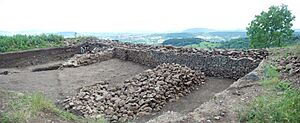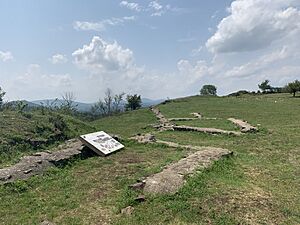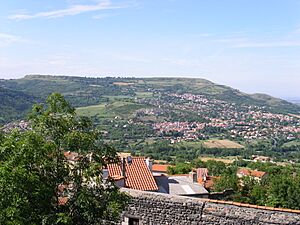Battle of Gergovia facts for kids
Quick facts for kids Battle of Gergovia |
|||||||
|---|---|---|---|---|---|---|---|
| Part of the Gallic Wars | |||||||
 Ancient Gergovia was located on the plateau in the background. The main battlefield was the area in the image's center right |
|||||||
|
|||||||
| Belligerents | |||||||
| Roman Republic | Gallic tribes | ||||||
| Commanders and leaders | |||||||
| Gaius Julius Caesar | Vercingetorix | ||||||
| Units involved | |||||||
|
|
||||||
| Strength | |||||||
|
Total: 20,000–45,000 Romans, auxiliaries and allies
|
30,000 Gauls, mostly Arverni | ||||||
| Casualties and losses | |||||||
| According to Julius Caesar: 46 centurions and 700 legionaries Modern estimates: Several thousand Roman and Aedui killed |
Unknown | ||||||
The Battle of Gergovia happened in 52 BC in Gaul, which is modern-day France. It was fought at Gergovia, a strong, fortified town (called an oppidum) belonging to the Arverni tribe. The battle was between the Roman Republican army, led by Julius Caesar, and Gallic forces, led by Vercingetorix. The Romans tried to surround Gergovia, but a mix-up ruined their plan. Gallic horsemen attacked the confused Romans, making them run away. This gave the Gauls a big victory.
Today, the battle site is believed to be near the village of Gergovie, close to Clermont-Ferrand in central France. You can still see some old walls and earthworks from that time. This battle is famous in France as a rare Gallic victory against Caesar.
How Did the Battle of Gergovia Start?
Most of what we know about this battle comes from Julius Caesar's own writings, called Commentaries on the Gallic War. There are no surviving accounts from the Gauls.
Vercingetorix's Return to Power
Vercingetorix had been forced out of Gergovia by its leaders. But in the winter of 53 BC, he returned. This time, his own people, the Arverni, supported him. Caesar faced a tough choice. He could keep his soldiers safe for the winter. But this might make Rome look weak to its allies, like the Aedui tribe. Instead, Caesar decided to fight Vercingetorix in an open battle. This risked running out of food and supplies.
Caesar's March to Gergovia
Caesar left two of his army groups (called legions) and all his supplies behind. He then led his other legions towards Gergovia. On the way, he attacked and captured several towns. This made Vercingetorix come out to fight Caesar in an open battle, which Caesar won. After that, Caesar captured another town, Avaricum, and got more supplies there.
After resting, Caesar sent his best general, Titus Labienus, with four legions to the north. This was to stop northern Gallic tribes from helping Vercingetorix. Caesar then headed straight for Gergovia. Vercingetorix probably guessed where Caesar was going.
The Stronghold of Gergovia
Gergovia was on a high plateau, about 360 meters (1,200 feet) above the flat land below. It was a very good place to defend. There was only one main way in, and a small group of soldiers could easily hold it.
Caesar's Clever Crossing
Vercingetorix crossed the powerful Elave River (now called the Allier River). He marched along the river, copying Caesar's moves. He also destroyed all the bridges. His goal was to attack Caesar's army while they tried to cross the river. Caesar realized this plan and decided to trick Vercingetorix.
One night, Caesar camped near a town where a bridge had been destroyed. He split his army into two parts. The larger part, two-thirds of his force, marched south. It looked like Caesar's entire army. Vercingetorix fell for the trick and followed this larger group.
Meanwhile, Caesar stayed with the smaller part of his army. They quickly rebuilt the bridge. Then, he sent for the larger force. The next day, they marched quickly to rejoin Caesar and crossed the rebuilt bridge. Vercingetorix realized he had been tricked. He rushed south to reach Gergovia before Caesar.
The Battle at Gergovia
Five days later, Caesar reached Gergovia. He saw that attacking the town directly would be too risky because of its mountain location. So, he decided to use his excellent siege skills. Caesar noticed a small hill nearby that the Gauls used for water and food.
Caesar attacked this hill at night and quickly captured it. He then built a large double trench, about 3.6 meters (12 feet) wide, connecting the hill to his main camp. This barrier stopped the Gauls from getting their supplies. They had to rely on a small stream inside Gergovia for water.
Aedui Tribe's Changing Loyalty
The Aedui tribe was supposed to be Rome's ally, but their loyalty was not strong. Caesar wrote that some Aedui leaders were bribed by Vercingetorix. Caesar had arranged for 10,000 Aedui soldiers to protect his supply lines. But Vercingetorix convinced their chief, Convictolitavis, to order these same men to join the Gauls instead. They attacked the Romans who were guarding the supplies. This put Caesar in a difficult spot.
With his food supplies threatened, Caesar took four legions from the siege. He surrounded the Aedui army and defeated them. The Aedui leaders who supported Rome then took back control. Caesar returned to Gergovia with 10,000 Aedui horsemen who were now loyal to Rome. The two legions he had left behind had struggled to hold off Vercingetorix's much larger force.
The Roman Attack and Retreat
Caesar realized his siege would fail unless he could get Vercingetorix off the high ground. He used one legion as a distraction. The rest of his army moved to better ground, capturing three Gallic camps easily. Caesar then ordered a general retreat to try and lure Vercingetorix down.
However, most of Caesar's soldiers did not hear the retreat order. They were excited by how easily they captured the camps. They kept pushing towards the town and tried to attack its walls directly. This made them very tired. The Romans also did not have ladders to climb the walls. When the Aedui arrived to help, the Romans mistakenly thought they were enemies and attacked them. Caesar could do little but cover his army's retreat.
The noise of the attack alerted Vercingetorix. He arrived and saw the Romans and Aedui fighting each other near the walls. Vercingetorix then led a charge of his horsemen, which broke the Roman lines. The Gallic warriors then got off their horses and joined the fight on foot. The Romans suffered heavy losses. Caesar claimed 46 centurions (army officers) and 700 legionaries were lost. However, many historians think Caesar made these numbers lower than they really were.
What Happened After the Battle?
Because of his losses, Caesar ordered his army to retreat. He lifted the siege and left the Arverni lands, heading northeast. Vercingetorix chased Caesar's army, hoping to destroy it. Caesar had to quickly pull his army out of Gaul.
Meanwhile, Labienus had finished his mission in the north. He marched back to Agedincum, Caesar's main base. Caesar joined up with Labienus's army. Then, their combined forces faced Vercingetorix's victorious army. Caesar won this next battle. He then chased Vercingetorix to Alesia. There, Caesar surrounded and eventually won the Battle of Alesia. This was a huge victory for Caesar and ended the Gallic Wars.
Even after Rome took control, Gergovia remained an important place for many years. But around 10–20 AD, the main local city was moved. Gergovia then became less important.
Gergovia's Legacy Today
Archaeology and Monuments
Emperor Napoleon III was very interested in history. He paid for research into France's Gallic past, including the battles of Gergovia and Alesia. Because of these digs, the village of Merdogne, near the battle site, was renamed Gergovie in 1865.
Interest in the battle has continued since the 1800s. A monument was built in 1900 on the plateau where the battle happened. In the 1990s, archaeologists found what they believe was the trench Caesar described. They also found many Roman items from that time. A new museum, the Musée de Gergovie, opened in October 2019. It is dedicated to the battle.
Gergovia in Pop Culture
The famous French comic book series Asterix makes a fun reference to the battle. This happens in the 1967 book Asterix and the Chieftain's Shield.




